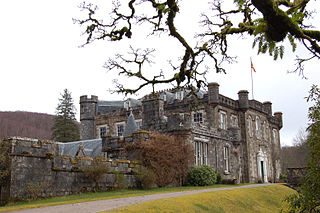 W
WAchnacarry is a small hamlet, private estate, and a castle in the Lochaber region of Highland, Scotland. It occupies a strategic position on an isthmus between Loch Lochy to the east, and Loch Arkaig to the west.
 W
WAckergill Tower is located on the coast of Sinclair's Bay, about 4 km north of Wick, Caithness, in northern Scotland. It was built in the early 16th century, and is a category A listed building. The building is a five-storey oblong tower house. The four-storey wing to the rear was added in the early 18th century.
 W
WArdtornish Castle is situated in the grounds of the Ardtornish estate in Morvern, on the west coast of Scotland. It stands at the seaward end of a promontory which extends in a southerly direction into the Sound of Mull, about 1 mile south-east of the village of Lochaline, Highland. It is protected as a scheduled monument.
 W
WArdvreck Castle is a ruined castle dating from the 16th century which stands on a rocky promontory jutting out into Loch Assynt in Sutherland, Scotland. One can reach the ruins by driving along the A837, which follows the north shore of Loch Assynt from the village of Inchnadamph.
 W
WBalconie Castle lay in the parish of Kiltearn, about 1⁄2 mile east of the village of Evanton in the Highlands of Scotland.
 W
WBalnagown Castle is located beside the village of Kildary in Easter Ross, part of the Highland area of Scotland. There has been a castle on the site since the 14th century, although the present building was remodelled in the 18th and 19th centuries. Balnagown is the ancestral home of the Chiefs of Clan Ross, although since the 1970s it has been owned by the Egyptian-born businessman Mohamed Al-Fayed. The castle is protected as a category B listed building, and the grounds are included on the Inventory of Gardens and Designed Landscapes in Scotland, the national listing of significant gardens.
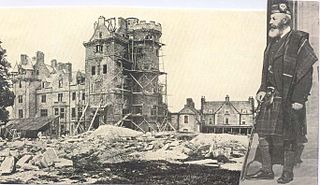 W
WBeaufort Castle or Castle Dounie is a Baronial style mansion built in 1880 and incorporating older building work. It is situated on the right bank of the River Beauly near the town of Beauly in Inverness-shire and is 1 mile (1.6 km) north of Kiltarlity and 13 mi (21 km) west of Inverness. There has been a castle on the site since the 12th century. Beaufort is the traditional seat of the Lords Lovat.
 W
WBraal Castle is located by the River Thurso north of the village of Halkirk, in Caithness, northern Scotland. The ruined castle, which dates back to the mid-14th century, was originally known as the Castle of Brathwell.
 W
WBrahan Castle was situated 3.5 miles (5.6 km) south-west of Dingwall, in Easter Ross, Scotland. The castle belonged to the Earls of Seaforth, chiefs of the Clan Mackenzie, who dominated the area.
 W
WCarbisdale Castle was built in 1907 for the Duchess of Sutherland on a hill across the Kyle of Sutherland from Invershin in the Scottish Highlands. Until 2011 it was used as a youth hostel, operated by the Scottish Youth Hostels Association. The castle is situated north of Culrain, and around 5 kilometres (3.1 mi) north-west of Bonar Bridge. The castle is in the Scots Baronial style, and is protected as a category B listed building. The hostel closed for repair in 2011, and as of August 2014 was put up for sale for £1.2m. In April 2016, the asking price was lowered to £900,000, and a sale was completed in September 2016. The buyers are FCFM Group Ltd who stated they intended to make it "a world-class private residence". In April 2021 it was reported that the castle was again for sale, priced at £1.5 million.
 W
WCastle Leod is the seat of the Clan Mackenzie. It is a category A listed building, and the grounds are listed in the Inventory of Gardens and Designed Landscapes of Scotland, the national listing of significant gardens. It is located near Strathpeffer in the east of Ross-shire in the Scottish Highlands.
 W
WCastle Varrich is in the far north of the Scottish Highlands, near the village of Tongue. The castle is on a local high point of rock, overlooking both the Kyle of Tongue and the village of Tongue. The castle's precise origins and age are unknown.
 W
WCastlecraig, also known as Craig Castle and Castle Craig, is a 16th-century fortification located on the north shore of the Black Isle in northern Scotland. It is on the south coast of the Cromarty Firth, 5 kilometres (3.1 mi) north-east of Culbokie and 19 kilometres (12 mi) north of the city of Inverness. The castle is protected as a scheduled monument.
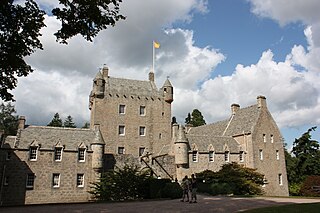 W
WCawdor Castle is a castle in the parish of Cawdor in Nairnshire, Scotland. It is built around a 15th-century tower house, with substantial additions in later centuries. Originally a property of the Calder family, it passed to the Campbells in the 16th century. It remains in Campbell ownership, and is now home to the Dowager Countess Cawdor, stepmother of Colin Campbell, 7th Earl Cawdor.
 W
WCastle Chanonry of Ross, also known as Seaforth Castle, was located in the town of Fortrose, to the north-east of Inverness, on the peninsula known as the Black Isle, Highland, Scotland. Nothing now remains of the castle. The castle was also known as Canonry or Chanonrie of Ross, the former county.
 W
WDalcross Castle is a restored 17th century tower house, about 1+1⁄2 miles southwest of Croy, Highland, Scotland, and about 7 miles northeast of Inverness. The castle stands on a ridge.
 W
WDornoch Castle is situated opposite Dornoch Cathedral in the town of Dornoch, in Sutherland, Scotland, a little over 40 miles (64 km) north of Inverness.
 W
WDounreay is a small settlement and the site of two large nuclear establishments on the north coast of Caithness in the Highland area of Scotland. It is on the A836 road nine miles west of Thurso.
 W
WDunbeath Castle is located on the east coast of Caithness, 2 kilometres (1.2 mi) south of Dunbeath, in northern Scotland. Although a castle has stood here since the 15th century, the present building is of mainly 17th-century origin, with 19th-century extensions. The castle is a Category A listed building and the grounds are included in the Inventory of Gardens and Designed Landscapes in Scotland.
 W
WDuncraig Castle is a mansion in Lochalsh, in the west of the Scottish Highlands. A category-C listed building, it is situated in the Highland council area, east of the village of Plockton on the south shore of Loch Carron. It was built in 1866 in the Scottish baronial style, to designs by Alexander Ross, for Scottish Member of Parliament and businessman Alexander Matheson. The castle remained in the Matheson family until the 1920s, when it was sold to Sir Daniel Hamilton and his wife Margaret, who owned the neighbouring estate. The Hamiltons intended to use the castle for educational purposes in the local community, but this never came to fruition and following the outbreak of World War II, the castle was used as a naval hospital. By the end of the war, Daniel Hamilton had died, and Margaret bequeathed the castle to the local council, which converted it for use as a home economics college for girls, operating in this capacity until its closure in 1989.
 W
WDunrobin Castle is a stately home in Sutherland, in the Highland area of Scotland, and the family seat of the Earl of Sutherland and the Clan Sutherland. It is located 1 mile (1.6 km) north of Golspie, and approximately 5 miles (8.0 km) south of Brora, overlooking the Dornoch Firth.
 W
WEilean Donan is a small tidal island situated at the confluence of three sea lochs in the western Highlands of Scotland, about 1 kilometre from the village of Dornie. It is connected to the mainland by a footbridge that was installed early in the 20th century, and is dominated by a picturesque castle that frequently appears in photographs, film and television. The island's original castle was built in the thirteenth century; it became a stronghold of the Clan Mackenzie and their allies, the Clan MacRae. However, in response to the Mackenzies' involvement in the Jacobite rebellions early in the 18th century, government ships destroyed the castle in 1719. The present-day castle is Lieutenant-Colonel John Macrae-Gilstrap's 20th-century reconstruction of the old castle.
 W
WErchless Castle is an L-plan castle in northern Scotland, near Struy, Highland. The current building was built in about 1600. The castle is located at the northeast end of Strathglass at the point where the Erchless Burn enters the River Beauly, itself newly formed from the confluence of the rivers Glass and Farrar immediately to the south of the castle.
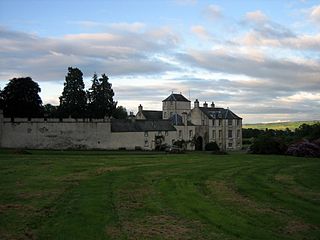 W
WFoulis Castle is situated two miles south-west of Evanton in the parish of Kiltearn, Ross and Cromarty, Scotland. It is a white washed mansion that incorporates an old tower house with gun loops. The castle was held by the Clan Munro from the twelfth century or earlier and they had a stronghold there.
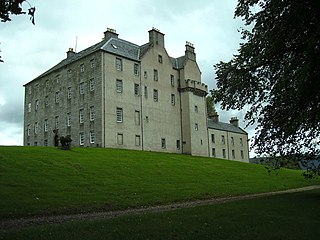 W
WCastle Grant stands a mile north of Grantown-on-Spey and was the former seat of the Clan Grant chiefs of Strathspey in Highlands, Scotland. It was originally named Freuchie Castle but was renamed Grant in 1694. The castle is a Category A listed building and the grounds are included in the Inventory of Gardens and Designed Landscapes in Scotland.
 W
WInvergarry Castle in the Scottish Highlands was the seat of the Chiefs of the Clan MacDonell of Glengarry, a powerful branch of the Clan Donald.
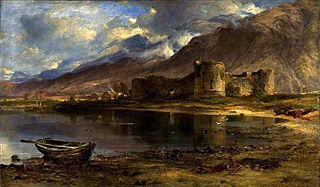 W
WInverlochy Castle is a ruined, 13th-century castle near Inverlochy and Fort William, Highland, Scotland. The site of two battles, the castle remains largely unchanged since its construction. It is now in the care of [Historic Environment Scotland].
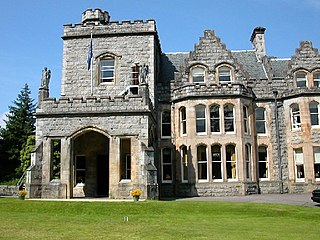 W
WInverlochy Castle Hotel, formerly known as Inverlochy Castle, is a 19th-century baronial mansion near Fort William, Scotland. It is located about two miles away from the 13th century Inverlochy Castle, after which it was named. This is a baronial mansion was built in 1863 by William Scarlett, 3rd Baron Abinger, soon after succeeding his father as Baron Abinger in 1861. Queen Victoria spent a week at Inverlochy during an 1873 visit to Balmoral, remarking "I never saw a lovelier or more romantic spot". The house and estate were sold in 1944 to a Canadian entrepreneur, Joseph Hobbs, the owner of the nearby Ben Nevis distillery. Upon inheriting the estate, Hobbs' son converted the house into a hotel, which opened for the first guests in 1969.
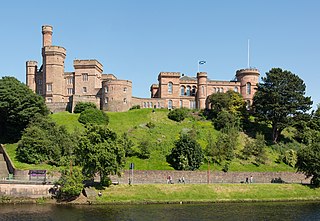 W
WInverness Castle sits on a cliff overlooking the River Ness in Inverness, Scotland. The red sandstone structure, displaying an early castellated style, is the work of a few nineteenth-century architects. William Burn (1789-1870) designed the Sheriff Court, Joseph Mitchell (1803-1883) the bastioned enclosing walls, and Thomas Brown II (1806-c.72) the District Court, originally built as a prison. It is built on the site of an 11th-century defensive structure. Until the 30th of March 2020 it housed Inverness Sheriff Court: this role has now been moved to the Inverness Justice Centre.
 W
WKeiss Castle is a partially ruined castle in Scotland, which stands on sheer cliffs overlooking Sinclair's Bay less than one mile north of Keiss village centre, Caithness, Highland, Scotland. It is protected as a scheduled monument. The old castle was replaced by Keiss House around 1755.
 W
WKilravock Castle is located near the village of Croy, between Inverness and Nairn, in the council area of Highland, Scotland. It was begun around 1460 and has been the seat of the Clan Rose since that time. The castle is a composite of a 15th-century tower house and several later additions. The original name for the castle was Cill Rathaig; Scottish Gaelic meaning "church at the small circular fort".
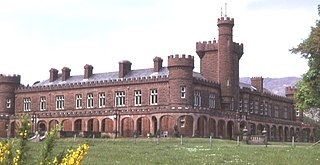 W
WKinloch Castle is a late Victorian mansion located on Kinloch, on the island of Rùm, one of the Small Isles off the west coast of Scotland. It was built as a private residence for Sir George Bullough, a textile tycoon from Lancashire whose father bought Rùm as his summer residence and shooting estate. Construction began in 1897, and was completed in 1900. Built as a luxurious retreat, Kinloch Castle has since declined. The castle and island are now owned by Scottish Natural Heritage, who operated part of the castle as a hostel until 2015, and continue to offer tours of the main rooms to visitors. The Kinloch Castle Friends Association was established in 1996 to secure the long-term future of the building.
 W
WKinlochaline Castle is a 15th-century Scottish tower house on the Ardtornish estate in Morvern in the Highland council area. It is also known as Caisteal an Ime because a Lady of Clan MacInnes, Dubh Chal, is said to have paid the builder with butter equal to the volume of the castle.
 W
WLochindorb is a freshwater loch north of Grantown on Spey in the Highland council area of Scotland. In the loch there is an island, which is now thought to have been artificially created, and on that island are the ruins of Lochindorb Castle, a former stronghold of the Clan Comyn. The loch is a popular spot with fishers, and also with birdwatchers, who come to see the local black-throated divers and greylag geese. At the southeast edge of the loch there is a small patch of coniferous forest.
 W
WThe Castle of Mey is located in Caithness, on the north coast of Scotland, about 6 miles (10 km) west of John o' Groats. In fine weather there are views from the castle north to the Orkney Islands.
 W
WMilntown Castle was an early 16th-century castle which was situated near Milton, in Easter Ross, in the Scottish Highlands.
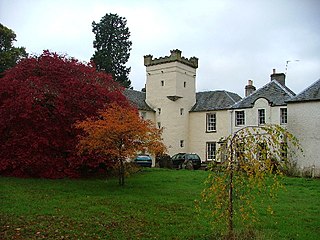 W
WMoniack Castle is a 16th-century tower house located 7 miles (11 km) west of Inverness, and just south of Beauly in Highland, Scotland. The castle was built in 1580 by members of the Clan Fraser. The castle is protected as a category B listed building.
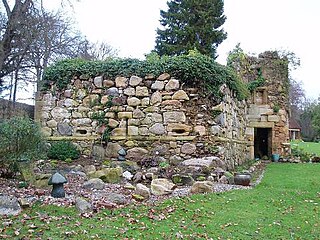 W
WNewmore Castle is situated just north of the town of Alness in Ross and Cromarty, Highland, Scotland.
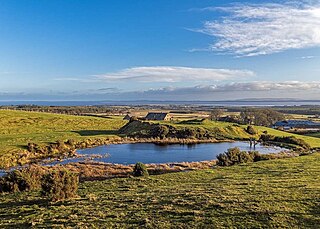 W
WProncy Castle is a ruined castle located near Dornoch, Highland, Scotland. It is within the historic county of Sutherland. The castle is positioned to command open views to the south over the Dornoch Firth.
 W
WRait Castle is a ruined hall-house castle dating from the thirteenth century, situated just south of Nairn near Inverness, Scotland. It is a scheduled monument.
 W
WSkelbo Castle is a ruined 14th century keep, located near Dornoch, Sutherland, Scotland. The remaining wall is best preserved at the northern side of the castle. The remains are protected as a scheduled monument. The castle is located at a former ferry crossing and commanded views over Loch Fleet.
 W
WSkibo Castle is located to the west of Dornoch in the Highland county of Sutherland, Scotland overlooking the Dornoch Firth. Although largely of the 19th century and early 20th century, when it was the home of industrialist Andrew Carnegie, its origins go back much earlier.
 W
WCastle Stuart is a restored tower house on the banks of the Moray Firth, about 6.5 miles (10 km) northeast of Inverness.
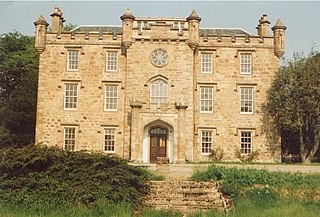 W
WTeaninich Castle is situated north of the village of Evanton and just south of the town of Alness in Ross and Cromarty, Scotland.
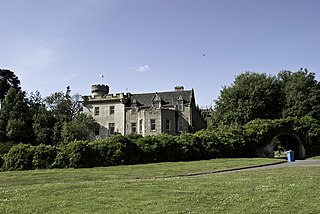 W
WTulloch Castle is located in the town of Dingwall in the Highlands of Scotland. It probably dates to the mid 16th century. Over the years, it has served as a family home for members of the Bain family, Clan Davidson, and Vickers family. The castle was used as a hospital after the evacuation of Dunkirk, and then as a hostel for the local education authority. It is currently used as a hotel and conference centre.